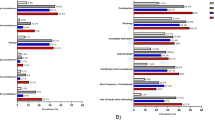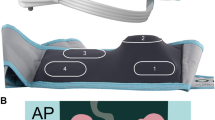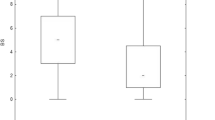Abstract
Study design:
Experimental, prospective study.
Objectives:
We evaluated the long-term clinical efficacy of transanal irrigation (TAI) and its effect on the quality of life of spina bifida children and their caregivers.
Setting:
Republic of Korea.
Method:
Forty-four spina bifida pediatric patients with constipation, fecal incontinence or both, underwent a TAI program at our spina bifida clinic between December 2010 and October 2013. The children and their caregivers were evaluated using a self-administered questionnaire before TAI and at 3 months and 3 years after initiation of the program.
Results:
Successful treatment outcome was achieved in 38 (86.4%) children after a mean follow-up duration of 33 months (range, 30–36). The mean number of fecal incontinence episodes per week, the number of diaper changes and the total time for bowel care per day before the program decreased at the latest follow-up examination from 7.3 to 0.4 (P<0.001), 1.6 to 0.2 (P<0.001) and 29.2 to 19.4 min (P=0.038), respectively. These results remained constant from short-term follow-up at 3 months to 3 years. Caregivers and children could go out more often (P=0.002), and the emotional impact of bowel care on caregivers decreased (P<0.001). The reported mean overall satisfaction with TAI was 8/10. The common adverse effect during TAI was abdominal discomfort (60.5%).
Conclusion:
We observed a sustained significant improvement in defecation symptoms and quality of life for 3 years in spina bifida children who underwent continuous TAI.
Similar content being viewed by others
Log in or create a free account to read this content
Gain free access to this article, as well as selected content from this journal and more on nature.com
or
References
Stevenson RE, Allen WP, Pai GS, Best R, Seaver LH, Dean J et al. Decline in prevalence of neural tube defects in a high-risk region of the United States. Pediatrics 2000; 106: 677–683.
Matsuno D, Yamazaki Y, Shiroyanagi Y, Ueda N, Suzuki M, Nishi M et al. The role of the retrograde colonic enema in children with spina bifida: is it inferior to the antegrade continence enema? Pediatr Surg Int 2010; 26: 529–533.
Vande Velde S, Van Biervliet S, Van Renterghem K, Van Laecke E, Hoebeke P, Van Winckel M . Achieving fecal continence in patients with spina bifida: a descriptive cohort study. J Urol 2007; 178: 2640–2644 discussion 2644.
Sawin KJ, Thompson NM . The experience of finding an effective bowel management program for children with spina bifida: the parent's perspective. J Pediatr Nurs 2009; 24: 280–291.
Krogh K, Lie HR, Bilenberg N, Laurberg S . Bowel function in Danish children with myelomeningocele. APMIS Suppl 2003; 109: 81–85.
Mattsson S, Gladh G . Tap-water enema for children with myelomeningocele and neurogenic bowel dysfunction. Acta Paediatr 2006; 95: 369–374.
Lemelle JL, Guillemin F, Aubert D, Guys JM, Lottmann H, Lortat-Jacob S et al. A multicentre study of the management of disorders of defecation in patients with spina bifida. Neurogastroenterol Motil 2006; 18: 123–128.
Christensen P, Kvitzau B, Krogh K, Buntzen S, Laurberg S . Neurogenic colorectal dysfunction - use of new antegrade and retrograde colonic wash-out methods. Spinal Cord 2000; 38: 255–261.
Bray L, Sanders C . An evidence-based review of the use of transanal irrigation in children and young people with neurogenic bowel. Spinal Cord 2013; 51: 88–93.
Cazemier M, Felt-Bersma RJ, Mulder CJ . Anal plugs and retrograde colonic irrigation are helpful in fecal incontinence or constipation. World J Gastroenterol 2007; 13: 3101–3105.
Liptak GS, Revell GM . Management of bowel dysfunction in children with spinal cord disease or injury by means of the enema continence catheter. J Pediatr 1992; 120: 190–194.
Eire PF, Cives RV, Gago MC . Faecal incontinence in children with spina bifida: the best conservative treatment. Spinal Cord 1998; 36: 774–776.
Lopez Pereira P, Salvador OP, Arcas JA, Martinez Urrutia MA, Romera RL, Monereo EJ . Transanal irrigation for the treatment of neuropathic bowel dysfunction. J Pediatr Urol 2010; 6: 134–138.
Choi EK, Shin SH, Im YJ, Kim MJ, Han SW . The effects of transanal irrigation as a stepwise bowel management program on the quality of life of children with spina bifida and their caregivers. Spinal Cord 2013; 51: 384–388.
Ausili E, Focarelli B, Tabacco F, Murolo D, Sigismondi M, Gasbarrini A et al. Transanal irrigation in myelomeningocele children: an alternative, safe and valid approach for neurogenic constipation. Spinal Cord 2010; 48: 560–565.
Neel KF . Total endoscopic and anal irrigation management approach to noncompliant neuropathic bladder in children: a good alternative. J Urol 2010; 184: 315–318.
Kanaheswari Y, Razak NN, Chandran V, Ong LC . Predictors of parenting stress in mothers of children with spina bifida. Spinal Cord 2011; 49: 376–380.
Lie HR, Lagergren J, Rasmussen F, Lagerkvist B, Hagelsteen J, Borjeson MC et al. Bowel and bladder control of children with myelomeningocele: a Nordic study. Dev Med Child Neurol 1991; 33: 1053–1061.
Rendeli C, Ausili E, Tabacco F, Caliandro P, Aprile I, Tonali P et al. Assessment of health status in children with spina bifida. Spinal Cord 2005; 43: 230–235.
Nanigian DK, Nguyen T, Tanaka ST, Cambio A, DiGrande A, Kurzrock EA . Development and validation of the fecal incontinence and constipation quality of life measure in children with spina bifida. J Urol 2008; 180: 1770–1773 discussion 1773.
Ok JH, Kurzrock EA . Objective measurement of quality of life changes after ACE Malone using the FICQOL survey. J Pediatr Urol 2011; 7: 389–393.
Rendeli C, Ausili E, Tabacco F, Focarelli B, Pantanella A, Di Rocco C et al. Polyethylene glycol 4000 vs. lactulose for the treatment of neurogenic constipation in myelomeningocele children: a randomized-controlled clinical trial. Aliment Pharmacol Ther 2006; 23: 1259–1265.
Faaborg PM, Christensen P, Kvitsau B, Buntzen S, Laurberg S, Krogh K . Long-term outcome and safety of transanal colonic irrigation for neurogenic bowel dysfunction. Spinal Cord 2009; 47: 545–549.
Christensen P, Krogh K, Buntzen S, Payandeh F, Laurberg S . Long-term outcome and safety of transanal irrigation for constipation and fecal incontinence. Dis Colon Rectum 2009; 52: 286–292.
Hamonet-Torny J, Bordes J, Daviet JC, Dalmay F, Joslin F, Salle JY . Long-term transanal irrigation's continuation at home. Preliminary study. Ann Phys Rehabil Med 2013; 56: 134–142.
Kim HR, Lee BS, Lee JE, Shin HI . Application of transanal irrigation for patients with spinal cord injury in South Korea: a 6-month follow-up study. Spinal Cord 2013; 51: 389–394.
Sanders C, Bray L . Examining professionals' and parents' views of using transanal irrigation with children: Understanding their experiences to develop a shared health resource for education and practise. J Child Health Care 2013; 18: 145–155.
Choi EK, Yoo IY . Resilience in families of children with Down syndrome in Korea. Int J Nurs Pract; e-pub ahead of print 22 April 2014.
Emmanuel AV, Krogh K, Bazzocchi G, Leroi AM, Bremers A, Leder D et al. Consensus review of best practice of transanal irrigation in adults. Spinal Cord 2013; 51: 732–738.
Burns CE . Pediatric primary care, 5th edn Elsevier: Philadelphia, PA. 2012.
Christensen P, Bazzocchi G, Coggrave M, Abel R, Hultling C, Krogh K et al. A randomized, controlled trial of transanal irrigation versus conservative bowel management in spinal cord-injured patients. Gastroenterology 2006; 131: 738–747.
Author information
Authors and Affiliations
Corresponding author
Ethics declarations
Competing interests
The authors declare no conflict of interest.
Appendix
Appendix
Items on Quality of Life Questionnaire related bowel management
Items (number of items)
Travel and socialization (8)
Child’s bowel care prevents him/her from going out of the house.
Child’s bowel care prevents me from going out of the house.
I avoid traveling with my child.
My child is afraid to go out because of stool incontinence.
I worry about the smell of my child’s stool incontinence.
My child’s worries about the smell of stool incontinence.
My child’s stool incontinence affects his/her ability to socialize and meet friends.
My child’s stool incontinence affects his/her physical activities (walking, sports, etc).
Caregiver support and emotional impact (6)
My child’s bowel care bothers me.
My child’s bladder care bothers me.
My child’s bowel problems make me feel depressed.
My child’s bowel problems make me feel anxious.
If my child was continence of stool, this would change my life.
If my child was continence of stool, this would change his/her life.
Family relationships (4)
My child’s bowel problems affect his/her relationship with siblings.
My child’s bowel problems affect my relationship with my other children.
My child’s bowel incontinence affects my relationship with my partner.
Financial impact (3)
Are you employed?
If no, does your child’s bowel care prevent you from working?
If you do work, how much does your child’s bowel care affect your job?
Rights and permissions
About this article
Cite this article
Choi, E., Han, S., Shin, S. et al. Long-term outcome of transanal irrigation for children with spina bifida. Spinal Cord 53, 216–220 (2015). https://doi.org/10.1038/sc.2014.234
Received:
Revised:
Accepted:
Published:
Issue date:
DOI: https://doi.org/10.1038/sc.2014.234
This article is cited by
-
Peristeen Transanal Irrigation System to Manage Bowel Dysfunction: A NICE Medical Technology Guidance
Applied Health Economics and Health Policy (2019)
-
Short versus mid-long-term outcome of transanal irrigation in children with spina bifida and anorectal malformations
Child's Nervous System (2018)
-
Management of Functional Constipation in Children: Therapy in Practice
Pediatric Drugs (2015)



